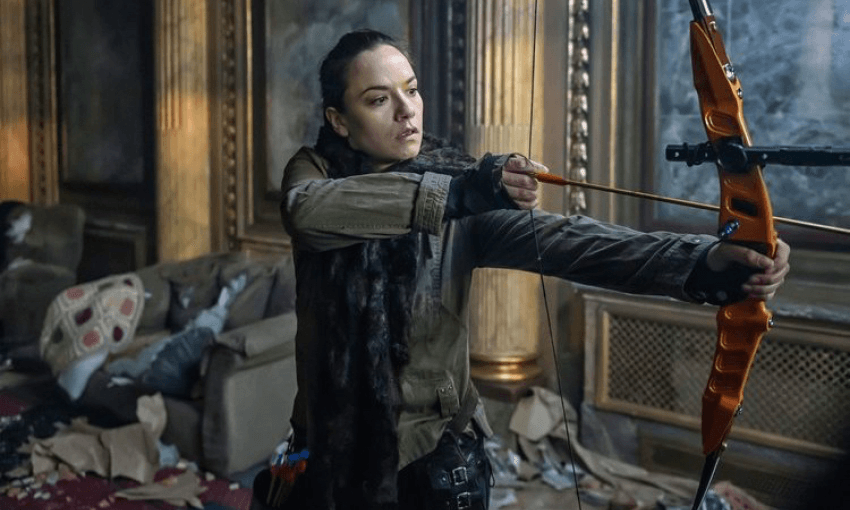A series of Māori Futurist events take place this weekend (July 6-8) at Ellen Melville Centre in Auckland’s CDB. Self-identified ‘Space Māori’ Dan Taipua picks out some highlights from the schedule.
In a few hundred years time the world will be washed into a new shape. Today’s islands will have disappeared from the the light of the sun and the touch of the air. New islands will be made from the peaks of our high lands. Everything below us and beside will shift with the rise of the sea. The only constant, the shape of the stars above us at night.
A programme of events, running this weekend in Auckland, brings together people who dream about and reflect on the future that awaits us. Artists and thinkers who stretch their imaginations to chart the possible and impossible: the Māori Futurists. In association with the Wairoa Māori Film Festival, and nestled in He Wiki Kiriata Māori (Māori Film Week), a series of short films, live presentations, musical performances and panel talks will examine the future imagined by Māori.
Speculation on the direction of time and space is a deep current in the culture of Māori: from our tales of creation and the narrative technologies that enabled celestial navigation across the Pacific Ocean, to distinct directorial touches on massive-budget sci-fi films like Thor: Ragnarok. It has picked up speed in recent years; perhaps due to the increased role of technology in daily life and the increased role Māori play in shaping the use and application of those technologies, or perhaps, the encroaching and unspeakable sense that time itself is speeding towards a singularity.
For Wairoa Film Festival organiser Leo Koizol, there were many stars that aligned to bring forth the Māori Futurism programme. “The number one reason there’s a futurist aspect is because I’m from Wairoa and we’re in the space age,” he says, in reference to the Rocket Lab launch site near his tūrangawaewae. “At Mahia, they’re launching rockets into outer space right from my whānau land.”
A second catalyst was the work of actor/musician Troy Kingi. “Troy is a mate of ours and came down to the film festival one year, then he went and made the Zygertron album,” Koziol adds, referring to the Māori/Meso-American/Afro-futurist concept album Kingi released in late 2017.
Koizol also ran across Radio New Zealand’s Aotearoa Futurism feature produced by myself and Sophie Wilson and realised the topics discussed were no longer concepts of the future: “This is the now – so let’s activate and get moving.”
Events run throughout the weekend with full details of the programme available in the Māori Film Week Programme Guide. Below is a selection of bright stars and an invitation to visit a far-off time in a nearby place.
First Flight to Zygertron with Troy Kingi
Friday 6th July, 6pm – Ellen Melville Centre
Troy Kingi is a buzzy dude. As the headline act for the festival, he presents a performance of his 70s soul-inspired, psychedelic concept album Shake That Skinny Ass All The Way Zygertron. Recorded with Mara TK and released late in 2017, Zygertron tells the story of a boy with golden feet, sent to the moon via a space-travelling pod beneath an ancient temple… or something like that. High harmonies feature throughout and the night-time performance includes special effects and complimentary non-alcoholic cocktails.
A Waka to Wakanda: International and Indigenous Solidarity
Friday 6th July, 8pm – Ellen Melville Centre
Like the Avengers, many powers assemble to make a mighty team of indigenous and international futurists in this screening of short films. Like Black Panther, each film shows the history and strength of proud futuristic cultures. The Māori hosts call on allies in the Cree, Mohawk and Navajo nations; Australian indigenous peoples and émigrés hop the ditch to lend a hand and, the works of African-American futurists are recognised and thanked. Highlights include a Mohawk recreation of the Star Wars: A New Hope trash compactor scene, Art world mashups of Sun Ra and Kraftwerk from Australian sisters Soda_Jerk, and Inuit animation.
Mini Māori Comic Con Panel
Saturday 7th July, 1-5pm – Ellen Melville Centre
Interspersed with on-topic short films, this mini-con features panel talks with creators across fields. Special guest Steven Paul Judd (Kiowa-Choctaw) joins the con to talk about his future-inflected, pop-inspired art and design work, as well as his works in film and television. Other panel guests include game designers and sci-fi writers and, the return of Troy Kingi who will be forced to explain what Zygertron means.





